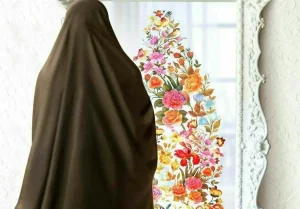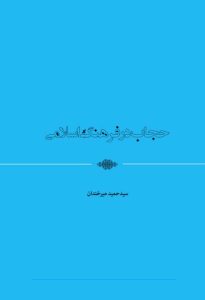ḤIJĀB DAR FARHANG ISLĀMĪ [ḤIJĀB IN ISLAMIC CULTURE]. By Seyed Hamid Mir Khandan. Qom, Iran: Daftar Nashr Ma‘āref. 2019. Pp. 160. Paper. 500,000 IRR.
The concept of women’s covering encompasses various dimensions, allowing for analyses from social, political, cultural, and even economic perspectives. Numerous works have been written about ḥijāb; however, what distinguishes this particular work is its focus on the historical evolution of women’s attire.
This work is structured with an introduction followed by 11 sections. In the first section, the author examines the concepts of ḥijāb, clothes, and covering. According to the book “Al-Taḥqīq Fī Kalimāt Al-Qur’ān,” the term hijab denotes a barrier or separator and is understood as preventing the convergence of two entities or the effects of one upon the other. The term ḥijāb is utilized in the Qur’an and traditions to signify “barrier and impediment.” In contrast, the term clothes, in “ Al-Taḥqīq Fī Kalimāt Al-Qur’ān,” is interpreted as covering in the sense of protection. In linguistic terms, covering refers to that which obscures another object. The author finds the term “covering” more appropriate among these three titles because it more clearly delineates the boundaries established in Islamic law regarding women’s attire. As previously mentioned, ḥijāb in Arabic implies a barrier or curtain, differing in meaning from its conventional understanding as a specific covering for women in Islam. Clothing serves as a manifestation of covering but is not appropriate as a title of discussion.
 The second section addresses the historical background of women’s coverings. The practice of covering predates Islam and earlier religions. From a revelatory perspective, based on Qur’anic verses, it is stated that humans have had covering since the beginning and have felt shame in its absence, making it a natural instinct. This section also references the views of scholars such as Bertrand Russell and Will Durant in “The Story of Civilization” regarding the contrast between nature and religion, as well as critiques of those views. Will Durant notes that in ancient Egyptian literature, signs of modesty and covering are observed, and in India, during 500-1000 BCE, ḥijāb and covering were customary for women. Moreover, in the Arabian Peninsula prior to the advent of Islam, women had coverings for their heads and bodies. According to poetry from the pre-Islamic era, veils were used to cover the face and seemingly were reserved for the upper classes of society. Durant’s “The Story of Civilization” states that during the Zoroastrian period among Iranians after Darius, it was obligatory for women, especially during menstruation, to seclude themselves. Additionally, no images of women have survived from ancient Iranian artifacts. After Zoroastrianism in Iran, women’s covering was similar to the chador. Historical reports indicate that in the Middle Ages, Jewish women did not appear in public with uncovered heads. Similarly, Christian women’s attire during this period involved covering their faces, though changes began in the Renaissance due to religious reforms in Europe, with significant alterations in clothing occurring from the twentieth century onward.
The second section addresses the historical background of women’s coverings. The practice of covering predates Islam and earlier religions. From a revelatory perspective, based on Qur’anic verses, it is stated that humans have had covering since the beginning and have felt shame in its absence, making it a natural instinct. This section also references the views of scholars such as Bertrand Russell and Will Durant in “The Story of Civilization” regarding the contrast between nature and religion, as well as critiques of those views. Will Durant notes that in ancient Egyptian literature, signs of modesty and covering are observed, and in India, during 500-1000 BCE, ḥijāb and covering were customary for women. Moreover, in the Arabian Peninsula prior to the advent of Islam, women had coverings for their heads and bodies. According to poetry from the pre-Islamic era, veils were used to cover the face and seemingly were reserved for the upper classes of society. Durant’s “The Story of Civilization” states that during the Zoroastrian period among Iranians after Darius, it was obligatory for women, especially during menstruation, to seclude themselves. Additionally, no images of women have survived from ancient Iranian artifacts. After Zoroastrianism in Iran, women’s covering was similar to the chador. Historical reports indicate that in the Middle Ages, Jewish women did not appear in public with uncovered heads. Similarly, Christian women’s attire during this period involved covering their faces, though changes began in the Renaissance due to religious reforms in Europe, with significant alterations in clothing occurring from the twentieth century onward.
The third section examines the rules of covering in Islam. Women’s Islamic covering is an obligation that has been legislated gradually. In the fifth year of Hijra, in Medina, following the Battle of the Confederates, verses concerning the manner of dress and interaction for the wives of the Prophet Muhammad (PBUH) were revealed. Subsequently, the legislation regarding women’s covering is highlighted in the verse: “O Prophet, tell your wives and your daughters and the women of the believers to draw their cloaks over themselves. That is more suitable that they will be known and not be harmed” (Qur’an 33:59). Throughout history, there has been variation in the interpretation of the measurement of the hijab, and overall, this verse does not specify the limits of covering. The concluding phrase of this verse indicates that wearing the cloak is preferable rather than obligatory. In the final stage of legislating a specific covering for believing women, the verse refers to the necessary guidelines: “And tell the believing women to lower their gaze and guard their private parts and not to reveal their adornment except that which [normally] appears thereof and to wrap [a portion of] their headcovers over their chests” (Qur’an 24:31). This verse delineates specific covering rules for believing women.
In the fourth section, the author discusses the context and foundations of covering as a regulatory measure in the dynamics between men and women, preserving family life, and achieving divine objectives. The fifth section is dedicated to the stipulations and etiquettes of covering, which, according to narrations, dictate that women cover their bodies except for their faces and hands up to their wrists. Additionally, women’s clothing should not be thin or tight such that it reveals the body. Elderly women’s covering is required to be less strict than that of younger women. Furthermore, women are not obligated to cover themselves in front of children and relatives -maḥārim- such as grandfather, father, father in law, brother, uncle, aunt, nephew, and niece. The stipulations for women’s attire during prayer are akin to those outside of prayer.
 The sixth section acknowledges the diversity of coverings and emphasizes that the significance for Islam lies not in specific garments but in the concept of covering itself, which may vary according to cultural contexts and historical periods. The seventh section outlines the benefits of adopting an Islamic covering, including the preservation of women’s dignity and respect, sexual tranquility, prevention of sexual deviations, and the reinforcement of family structures. The eighth section investigates the relationship between governmental authority and women’s covering, considering various dimensions such as guidance, legal enforcement, and the establishment of institutions to manage and regulate women’s attire in public spaces.
The sixth section acknowledges the diversity of coverings and emphasizes that the significance for Islam lies not in specific garments but in the concept of covering itself, which may vary according to cultural contexts and historical periods. The seventh section outlines the benefits of adopting an Islamic covering, including the preservation of women’s dignity and respect, sexual tranquility, prevention of sexual deviations, and the reinforcement of family structures. The eighth section investigates the relationship between governmental authority and women’s covering, considering various dimensions such as guidance, legal enforcement, and the establishment of institutions to manage and regulate women’s attire in public spaces.
The ninth section critiques various arguments posited against ḥijāb. It is occasionally asserted that a woman should be modest, with her virtue not dependent on her clothing, emphasizing that a healthy moral relationship between men and women is paramount, thus negating the need for specific coverings. The author counters that modesty encompasses both inner and outer behavioral aspects, implying that someone who embraces modesty will manifest it through their attire, as appropriate clothing can be an indicator of a woman’s chastity. Additional doubts are expressed regarding the notion that hijab restricts women’s freedoms. The author clarifies that freedom within any doctrine is delineated by boundaries that should not infringe upon the rights of others and that actions causing harm to others should be curtailed.
The tenth section identifies factors contributing to the avoidance of Islamic covering, such as political influences, communication methods, extremities in addressing women’s attire, and a lack of conducive environments for women’s activities within society. The final section reiterates that women’s covering is a dimension of women’s issues and cannot be examined in isolation without considering other aspects of male-female relations, women’s roles within families, and their societal contributions according to religious perspectives. The multifaceted nature of women’s covering necessitates careful and thoughtful discourse in its understanding.
In the introductory segment, the author notes that the term “Islamic covering” is more suitably aligned than “Islamic ḥijāb,” suggesting that such a nomenclature change be adopted throughout this work to maintain consistency, advocating for the term “covering” in place of ” ḥijāb” to achieve a cohesive narrative throughout the text.
Hossein Baqeri
Tolou International Institute
